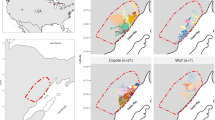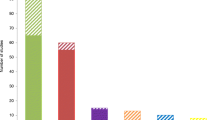Abstract
Habitat loss is known to be the main cause of the current global decline in biodiversity, and roads are thought to affect the persistence of many species by restricting movement between habitat patches. However, measuring the effects of roads and habitat loss separately means that the configuration of habitat relative to roads is not considered. We present a new measure of the combined effects of roads and habitat amount: accessible habitat. We define accessible habitat as the amount of habitat that can be reached from a focal habitat patch without crossing a road, and make available a GIS tool to calculate accessible habitat. We hypothesize that accessible habitat will be the best predictor of the effects of habitat loss and roads for any species for which roads are a major barrier to movement. We conducted a case study of the utility of the accessible habitat concept using a data set of anuran species richness from 27 ponds near a motorway. We defined habitat as forest in this example. We found that accessible habitat was not only a better predictor of species richness than total habitat in the landscape or distance to the motorway, but also that by failing to consider accessible habitat we would have incorrectly concluded that there was no effect of habitat amount on species richness.



Similar content being viewed by others
References
Andren H (1994) Effects of habitat fragmentation on birds and mammals in landscapes with different proportions of suitable habitat––a review. Oikos 71:355–366
Aresco MJ (2005) The effect of sex-specific terrestrial movements and roads on the sex ratio of freshwater turtles. Biol Conserv 123:37–44
Bhattacharya M, Primack RB, Gerwein J (2003) Are roads and railroads barriers to bumblebee movement in a temperate suburban conservation area? Biol Conserv 109:37–45
Bishop CA, Petit KE, Gartshore ME et al (1997) Extensive monitoring of anuran populations using call counts and road transects in Ontario (1992 to 1993). In: Green DM (ed) Amphibians in decline: Canadian studies of a global problem. Herpetological conservation, vol 1. Society for the Study of Amphibians and Reptiles, St Louis USA, pp 149–160
Carr LW, Fahrig L (2001) Effect of road traffic on two amphibian species of differing vagility. Conserv Biol 15:1071–1078
Clarke GP, White PCL, Harris S (1998) Effects of roads on badger Meles meles populations in south-west England. Biol Conserv 86:117–124
deMaynadier PG, Hunter ML (1999) Forest canopy closure and juvenile emigration by pool-breeding amphibians in Maine. J Wildlife Manag 63:441–450
deMaynadier PG, Hunter ML (2000) Road effects on amphibian movements in a forested landscape. Nat Areas J 20:56–65
de Solla SR, Shirose LJ, Fernie KJ et al (2005) Effect of sampling effort and species detectability on volunteer based anuran monitoring programs. Biol Conserv 121:585–594
Epps CW, Palsboll PJ, Wehausen JD et al (2005) Highways block gene flow and cause a rapid decline in genetic diversity of desert bighorn sheep. Ecol Lett 8:1029–1038
Fahrig L (2003) Effects of habitat fragmentation on biodiversity. Ann Rev Ecol Evol Syst 34:487–515
Fahrig L, Pedlar JH, Pope SE et al (1995) Effect of road traffic on amphibian density. Biol Conserv 73:177–182
Findlay CS, Lenton J, Zheng LG (2001) Land-use correlates of anuran community richness and composition in southeastern Ontario wetlands. Ecoscience 8:336–343
Forman RTT, Alexander LE (1998) Roads and their major ecological effects. Ann Rev Ecol Evol Syst 29:207–231
Forman RTT, Deblinger RD (2000) The ecological road-effect zone of a Massachusetts (USA) suburban highway. Conserv Biol 14:36–46
Fox J (2002) An R and S-Plus companion to applied regression. Sage Publications, Thousand Oaks
Fox J (2006) Car: Companion to applied regression. R package version 1.1–0. Available from http://www.R-project.org (Accessed March 2007)
Gagné SA, Fahrig L (2007) Effect of landscape context on anuran communities in breeding ponds in the National Capital Region, Canada. Landsc Ecol 22:205–215
Guerry AD, Hunter ML (2002) Amphibian distributions in a landscape of forests and agriculture: and examination of landscape composition and configuration. Cons Biol 2002:745–754
Gutzwiller KJ, Barrow WC (2003) Influences of roads and development on bird communities in protected Chihuahuan Desert landscapes. Biol Conserv 113:225–237
Harding JH (1997) Amphibians and reptiles of the Great Lakes region. University of Michigan Press, Ann Arbor, USA
Hecnar SJ, M’Closkey RT (1998) Species richness patterns of amphibians in southwestern Ontario ponds. J Biogeog 25:763–772
Hels T, Buchwald E (2001) The effect of road kills on amphibian populations. Biol Conserv 99:331–340
Herrmann HL, Babbitt KJ, Baber MJ et al (2005) Effects of landscape characteristics on amphibian distribution in a forest-dominated landscape. Biol Conserv 123:139–149
Houlahan JE, Findlay CS (2003) The effects of adjacent land use on wetland amphibian species richness and community composition. Can J Fish Aquat Sci 60:1078–1094
Johnson WC, Collinge SK (2004) Landscape effects on black-tailed prairie dog colonies. Biol Conserv 115:487–497
Keller I, Largiader CR (2003) Recent habitat fragmentation caused by major roads leads to reduction of gene flow and loss of genetic variability in ground beetles. Proc Royal Soc London B Biol Sci 270:417–423
Knutson MG, Richardson WB, Reineke DM et al (2004) Agricultural ponds support amphibian populations. Ecol Apps 14:669–684
Knutson MG, Sauer JR, Olsen DA et al. (1999) Effects of landscape composition and wetland fragmentation on frog and toad abundance and species richness in Iowa and Wisconsin, USA. Conserv Biol 13:1437–1446
Kuehn R, Hindenlang KE, Holzgang O et al (2007) Genetic effect of transportation infrastructure on roe deer populations (Capreolus capreolus). J Hered 98:13–22
Laan R, Verboom B (1990) Effects of pool size and isolation on amphibian communities. Biol Conserv 54:251–262
Lesbarreres D, Primmer CR, Lode T et al (2006) The effects of 20 years of highway presence on the genetic structure of Rana dalmatina populations. Ecoscience 13:531–538
Mace RD, Waller JS, Manley TL et al (1996) Relationships among grizzly bears, roads and habitat in the Swan Mountains, Montana. J App Ecol 33:1395–1404
Mader HJ (1984) Animal habitat isolation by roads and agricultural fields. Biol Conserv 29:81–96
Marchand MN, Litvaitis JA (2004) Effects of habitat features and landscape composition on the population structure of a common aquatic turtle in a region undergoing rapid development. Conserv Biol 18:758–767
Ontario Ministry of Transportation (2003) Provincial highways traffic volumes 1988–2003. Engineering standards branch, traffic office, Toronto
Oxley DJ, Fenton MB, Carmody GR (1974) Effects of roads on populations of small mammals. J App Ecol 11:51–59
Petranka JW, Smith CK, Scott AF (2004) Identifying the minimal demographic unit for monitoring pond-breeding amphibians. Ecol Apps 14:1065–1078
Price JS, Marks DR, Howe RW et al (2004) The importance of spatial scale for conservation and assessment of anuran populations in coastal wetlands in the western Great Lakes, USA. Landsc Ecol 20:441–454
R Development Core Team (2005) R: A language and environment for statistical computing. R Foundation for Statistical Computing, Vienna, Austria. Available from http://www.R-project.org (Accessed March 2007)
Reh W, Seitz A (1990) The influence of land use on the genetic structure of populations of the common frog Rana temporaria. Biol Conserv 54:239–249
Riley SPD, Pollinger JP, Sauvajot RM et al (2006) A southern California freeway is a physical and social barrier to gene flow in carnivores. Mol Ecol 15:1733–1741
Shine R, Lemaster M, Wall M et al (2004) Why did the snake cross the road? Effects of roads on movement and location of mates by garter snakes (Thamnophis sirtalis parietalis). Ecol Soc 9: [online] http://www.ecologyandsociety.org/vol9/iss1/art9/
Skelly DK, Werner EE, Cortwright SA (1999) Long-term distributional dynamics of a Michigan amphibian assemblage. Ecol 80:2326–2337
Steen DA, Gibbs JP (2004) Effects of roads on the structure of freshwater turtle populations. Conserv Biol 18:1143–1148
Swihart RK, Slade NA (1984) Road crossing in Sigmodon hispidus and Microtus ochrogaster. J Mammal 65:357–360
Todd BD, Winne CT (2006) Ontogenetic and interspecific variation in timing of movement and responses to climatic factors during migrations by pond-breeding amphibians. Can J Zool 84:715–722
Trombulak SC, Frissell CA (2000) Review of the ecological effects of roads on terrestrial and aquatic ecosystems. Conserv Biol 14:18–30
Van Gelder JJ (1973) A quantitative approach to the mortality resulting from traffic in a population of Bufo bufo L. Oecologia 13:93–95
Vos CC, Chardon JP (1998) Effects of habitat fragmentation and road density on the distribution pattern of the moor frog Rana arvalis. J Appl Ecol 35:44–56
Wilbur HM (1980) Complex life-cycles. Ann Rev Ecol Evol Syst 11:67–93
Zar JH (1999) Biostatistical analysis. Prentice Hall, Upper Saddle River, New Jersey, USA
Acknowledgements
This study would not have been possible without the co-operation of many private landowners. We would also like to thank Kristen Keyes and Alison Callahan for their help in the field, many volunteers (especially Katy Heady, Wes von Papineau, Paul Sokoloff and Anne and Dean Keyes) for their help with the fieldwork and with logistic support, and the members of the GLEL for their helpful comments on the manuscript. Funding was provided through a Natural Sciences and Engineering Research Council of Canada (NSERC) Doctoral Scholarship and Carleton University scholarships to Felix Eigenbrod, and NSERC Discovery Grants to Stephen J. Hecnar and Lenore Fahrig.
Author information
Authors and Affiliations
Corresponding author
Rights and permissions
About this article
Cite this article
Eigenbrod, F., Hecnar, S.J. & Fahrig, L. Accessible habitat: an improved measure of the effects of habitat loss and roads on wildlife populations. Landscape Ecol 23, 159–168 (2008). https://doi.org/10.1007/s10980-007-9174-7
Received:
Accepted:
Published:
Issue Date:
DOI: https://doi.org/10.1007/s10980-007-9174-7




